Abstract
Lightcurves for eleven asteroids were obtained at the Center for Solar System Studies-Palmer Divide Station (CS3-PDS) in 2013 May and June. The asteroids were a mostly a mix of Hungaria and Phocaea members along with some outer main-belt asteroids. New data failed to remove the existing rotation period ambiguity for the Hungaria asteroid 1355 Magoeba, although the number of possibilities may have been reduced. A new period is proposed for 4436 Ortizmoreno, 8.24 h (or 16.48 h), superseding the one reported by Birlan et al. (1996). The Hungaria member 26074 Carlwirtz may be a binary with a primary rotation period of P1 = 2.5493 ± 0.0003 h and a satellite orbital period of Porb = 16.11 ± 0.02 h. The Phocaea member (125742) 2001 XT117 shows signs of a low amplitude precision period, i.e., it is possibly in non-principal axis rotation (NPAR).
CCD photometric observations of eleven asteroids were made at the Center for Solar System Studies-Palmer Divide Station (CS3-PDS) in 2013 May and June. See the introduction in Warner (2010b) for a discussion of equipment, analysis software and methods, and overview of the lightcurve plot scaling.
These are the first observations to be made at PDS after the telescopes were moved from Colorado to the CS3 site in Landers, CA. All the telescopes are fully robotic, with custom software and equipment allowing fully-unattended control of all aspects of observing, from opening/closing the roof, acquiring images, and transferring those images back to processing computers in Colorado. It’s anticipated that the new location will allow an additional 60–80 observing nights per year beyond what was possible at the now closed Palmer Divide Observatory site in Colorado.
In the plots below, the “Reduced Magnitude” is Johnson V or Cousins R (indicated in the Y-axis title) corrected to unity distance by applying –5*log (rΔ) to the measured sky magnitudes with r and Δ being, respectively, the Sun-asteroid and Earth-asteroid distances in AU. The magnitudes were normalized to the phase angle given in parentheses, e.g., alpha(6.5°), using G = 0.15, unless otherwise stated. The horizontal axis is the rotational phase, ranging from 0.0 to 1.0.
For the sake of brevity, only some of the previously reported results may be referenced in the discussions on specific asteroids. For a more complete listing, the reader is referred to the asteroid lightcurve database (LCDB, Warner et al. 2009). The on-line version allows direct queries that can be filtered a number of ways and the results saved to a text file. A set of text files, including the references with bibcodes, is also available for download at http://www.minorplanet.info/lightcurvedatabase.html. Readers are strongly encouraged to obtain, when possible, the original references listed in the LCDB for their work.
1355 Magoeba
Finding the period for this enigmatic Hungaria asteroid has been a challenge over the years, mostly because the lightcurve amplitude rarely rises above 0.10 mag and is often <0.05 mag. Warner (2007) observed 1355 in 2006 and reported a period of 32.9 h with an amplitude of 0.22 mag. That was subsequently revised (Warner, 2010a) to 31.65 h and 0.10 mag. New observations in late 2009 lead to a shorter period of 5.946 h, which was based on the assumption of a bimodal lightcurve. Additional observations (Warner, 2011), lead to a period of 5.99 h, but the 0.06 mag amplitude made that solution ambiguous.
The new observations in 2013 from CS3-PDS did not resolve the ambiguities. The period spectrum below shows that a number of like-probability solutions were possible; one of those was 2.977 h, or about the half-period of the ~5.9 h solution. The first lightcurve in the set below shows the 2013 data phased to the 2.977 h solution. When plotting the data for the double period to look for symmetry in the shape, a period of about 5.2 h was favored over 5.9 h. The 2013 data were forced to the half-period, which found 2.644 h. This is the second lightcurve in the Magoeba set. Note that the shape of the two 2013 lightcurves is essentially identical. By simple visual inspection, it is not possible to tell which solution is the right one, if either.
The best data set prior to 2013 from PDO was late 2009. These data were forced to periods near 2.97 and 2.64 h. These are shown in the third and fourth lightcurves in the series. The fit to 2.97 h is noticeably the better of the two. For this reason, it’s suggested that a period of 2.97 h (or 5.94 h) be adopted for this asteroid. Now that there are data from four apparitions with a useful distribution in phase angle bisector longitudes, it might be possible to apply lightcurve inversion techniques to see which period gives a more probable model. Then again, it may take a few more years of trying before this mystery’s riddle is solved.
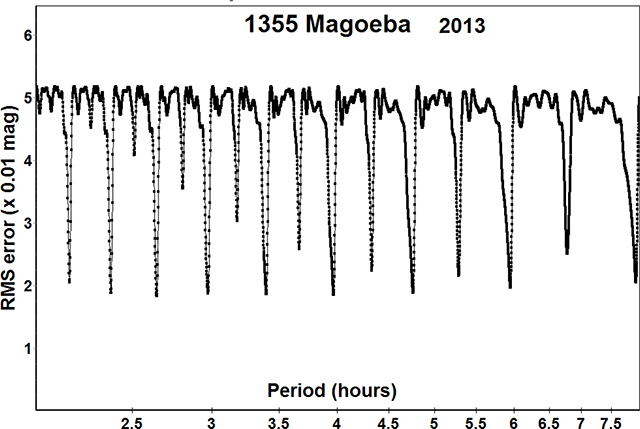




2150 Nyctimene
2013 was the fourth apparition at which this Hungaria was observed by the author (Warner 2007; 2008; 2012). The period of 6.124 ± 0.005 h is in good agreement with the earlier results. The amplitude of the asteroid has ranged from 0.59 to 0.66 mag. Not only does this indicate an elongated ellipsoidal body with an a/b ratio of about 1.8:1 (assuming an equatorial view) but that the spin axis has a small-to- modest obliquity, i.e., it is mostly upright with reference to the ecliptic plane.

4436 Ortizmoreno
Birlan et al. (1996) reported a period of 6.656 h for this outer main-belt asteroid with an amplitude of 0.40 mag. The 2013 data could not be fit to this period, the analysis finding a period of 8.24 ± 0.02 h and an amplitude of 0.09 mag if a monomodal solution is presumed. Since the low phase angle and amplitude combine to make this assumption unreliable, the double-period of 16.48 h with a bimodal lightcurve cannot be formally excluded. Lightcurves for both periods are shown below.
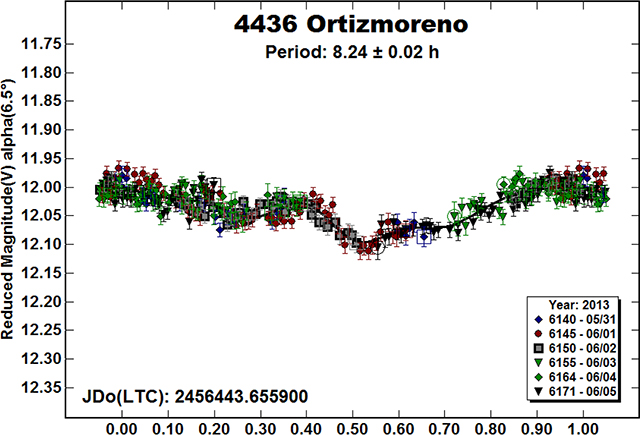

4497 Taguchi
None of the previous periods for this inner main-belt asteroid agreed with one another, although two were similar. Almeida et al. (2004) found 3.563 h; Clark (2006) found 5.343 h; and Behrend (2008) reported a period of 3.49 h, which is similar to the Almeida finding. It’s worth noting that Clark’s result is almost exactly 1.5x the Almeida period, possibly indicating that the longer period was a result of rotational aliasing, which is a miscount of the rotations within the data set. For example, if a lightcurve is nearly symmetrical and the two data sets are taken several days apart and at least one lightcurve doesn’t cover even a half-cycle, then opposing halves of the lightcurve may be mistaken as being from the same half.
Analysis of the CS3-PDS data found a period of 3.563 ± 0.003 h and amplitude of 0.11 mag. There appears to be enough asymmetry in the lightcurve to presume that the solution is not ambiguous and, furthermore, it agrees exactly with the Almeida et al. solution.

5211 Stevenson
No previously reported period could be found for this Phocaea member.
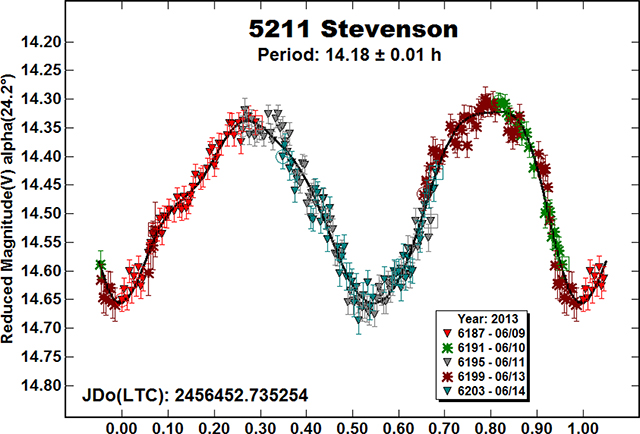
(8893) 1995 KZ
No previously reported period was found for this Phocaea member.

(19204) 1992 ME
Previous work on this Phocaea member includes Stephens (2006), who reported a period of 3.17 h, and Pravec et al. (2006), who found the period to be >10 h. The 2013 data show a monomodal lightcurve with an amplitude of only 0.10 mag and period of 19.5 ± 0.1 h. Other than forcing the period to the double, i.e., 39 h, and a bimodal solution, there were no other likely periods. This would seem to confirm the Pravec et al. result but it should not be considered definitive.
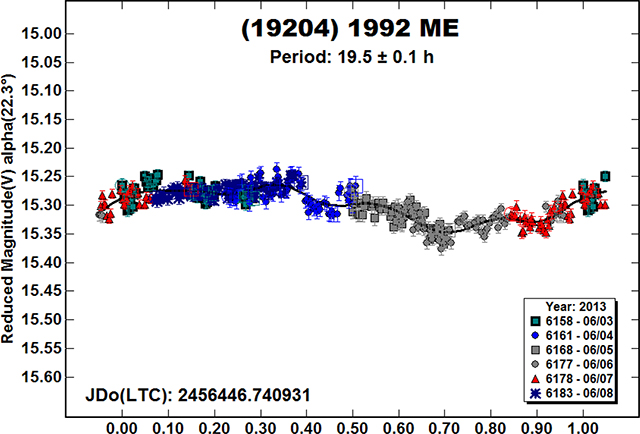
(24778) 2000 WC145
This appears to be the first time a period has been found for this outer main-belt asteroid. The period was nearly an integral ratio with an Earth-day; so, even over a span of eight days, there are some small gaps in the lightcurve. Despite this and the slightly noisy data, the solution is considered secure.

(26074) Carlwirtz
This Hungaria asteroid seems to be a probable new binary discovery. The first lightcurve in the series below shows the data forced to a period of 2.5492 ± 0.0003 h with no subtraction. There is considerable scatter about the mean Fourier curve. When a secondary period of 16.11 h is subtracted from the data, a considerably better fit is achieved. This is shown in the second lightcurve of the set. The third lightcurve in the set shows the secondary period after subtracting the primary period from the data. It shows no obvious signs of mutual events that would be the result of occultations and/or eclipses involving a satellite. Instead, it appears to be a bimodal lightcurve with an amplitude of 0.09 mag. The period is nearly 2:3 of an Earth-day. This made it difficult for a single station to fill in the missing pieces of the lightcurve.
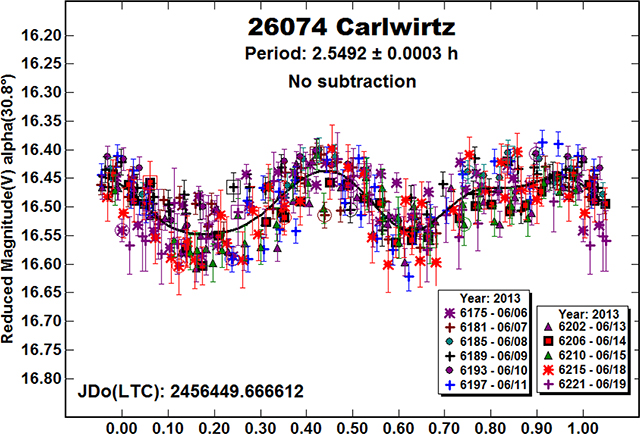


(41185) 1999 VJ200
This outer main-belt member was a target of opportunity, meaning it was in the same field as a planned target. It was well below 18th magnitude and so the data have significant error bars. A second night was given to see if a reasonable period could be derived. The apparent amplitude of 0.39 mag gives some credence to the solution of 4.97 ± 0.03 h but many other solutions are possible with adjustments to the nightly zero points of the data from two nights (second lightcurve in set). Using only the data from the first night, 2013 June 19, which appears to show most of a bimodal lightcurve cycle, a second-order Fourier solution finds a period of 3.92 ± 0.15 h and amplitude of 0.39 ± 0.03 mag (first lightcurve in set). Given the significantly larger error bars on the second night (June 20) and doubts about the fit of the data from two nights, the adopted period is 3.92 h –with the understanding that it could differ from the true period by considerably more than the stated error of 0.15 h.


(125742) 2001 XT117
This asteroid is a member of the Phocaea group. No previously reported period could be found. The base period of 60.8 ± 0.2 h seems secure. However, there are some indications that the asteroid may be a tumbler, i.e., in non-principal axis rotation (NPAR; see Pravec et al. 2005). Those indications are slight misfits of some sessions that overlapped with others, e.g., session 6184 (2013 June 8) has a steeper slope and higher maximum than the data from other sessions around the same rotation phase. There are similar indications around 0.9 rotation phase. The small deviations would seem to indicate that the amount of “wobble” is small and that maybe the asteroid is just coming into or out of its NPAR state.

Table I.
Observing circumstances. Asteroids with (H) after the name are members of the Hungaria group/family. The phase angle (α) is given at the start and end of each date range, unless it reached a minimum, which is then the second of three values. If a single value is given, the phase angle did not change significantly and the average value is given. LPAB and BPAB are each the average phase angle bisector longitude and latitude, unless two values are given (first/last date in range).
| Number | Name | 2013 (mm/dd) | Pts | Phase | LPAB | BPAB | Period | P. E. | Amp | A.E. |
|---|---|---|---|---|---|---|---|---|---|---|
| 1355 | Magoeba (H) | 05/27–06/05 | 127 | 33.9,34.6 | 187 | −10 | 2.977 | 0.005 | 0.15 | 0.01 |
| 11/22–11/25^ | 259 | 5.7,7.2 | 56 | −8 | 2.972 | 0.002 | 0.10 | 0.01 | ||
| 2150 | Nyctimene (H) | 05/27–06/07 | 272 | 28.2,29.7 | 193 | +4 | 6.124 | 0.005 | 0.66 | 0.02 |
| 4436 | Ortizmoreno (H) | 05/31–06/05 | 310 | 6.4,7.7 | 235 | +11 | 8.24 | 0.02 | 0.09 | 0.01 |
| 4497 | Taguchi (H) | 05/31–06/03 | 207 | 7.8,8.8 | 231 | +7 | 3.563 | 0.003 | 0.11 | 0.01 |
| 5211 | Stevenson | 06/09–06/14 | 240 | 24.1,25.0 | 226 | +34 | 14.18 | 0.01 | 0.33 | 0.02 |
| 8893 | 1995 KZ | 06/04–06/14 | 668 | 21.0,22.2 | 245 | +33 | 22.27 | 0.02 | 0.39 | 0.02 |
| 19204 | 1992 ME | 06/03–06/08 | 332 | 22.3,21.0 | 262 | +27 | 19.55 | 0.10 | 0.08 | 0.01 |
| 24478 | 2000 WC145 | 06/15–06/23 | 326 | 17.7,18.9 | 238 | +31 | 16.13 | 0.03 | 0.43 | 0.03 |
| 26074 | Carlwirtz (H) | 06/06–06/19 | 330 | 30.7,31.8 | 227 | +33 | 2.5493* | 0.0003 | 0.11 | 0.01 |
| 41185 | 1999 VJ200 | 06/19–06/20 | 74 | 12.2,12.4 | 241 | +21 | 3.92 | 0.15 | 0.39 | 0.03 |
| 125742 | 2001 XT117 | 06/04–06/19 | 712 | 20.4,22.6 | 244 | +21 | 60.8# | 0.2 | 1.15 | 0.05 |
2009
period of binary primary
dominant period of a tumbler
Acknowledgements
Funding for observations at the CS3-Palmer Divide Station was provided in part by National Science Foundation grant AST-1032896.
References
- Almeida R, Angeli CA, Duffard R, and Lazzaro D (2004). “Rotation periods for small main-belt asteroids.” Astron. Astrophys 415, 403–406. [Google Scholar]
- Behrend R (2008). Observatoire de Geneve web site, http://obswww.unige.ch/~behrend/page_cou.html
- Birlan M, Barucci MA, Angeli CA, Doressoundiram A, and De Sanctis MC (1996). Planet. Space Sci. 44, 555–558. [Google Scholar]
- Clark M (2006). “Lightcurve results for 383 Janina, 899 Jokaste, 1825 Klare, 2525 O’Steen 5064 Tanchozuru, and (17939) 1999 HH8.” Minor Planet Bul. 33, 53–56. [Google Scholar]
- Pravec P, Harris AW, Scheirich P, Kušnirák P, Šarounová L, Hergenrother CW, Mottola S, Hicks MD, Masi G, Krugly, Yu N, Shevchenko VG, Nolan MC, Howell ES, Kaasalainen M, Galád A, Brown P, Degraff DR, Lambert JV, Cooney WR, and Foglia S (2005). “Tumbling asteroids.” Icarus 173, 108–131. [Google Scholar]
- Pravec P; Wolf M; Sarounova L (2006) http://www.asu.cas.cz/~ppravec/neo.htm
- Stephens RD (2006). “Asteroid lightcurve photometry from Santana and GMARS observatories - winter and spring 2006.” Minor Planet Bul. 33, 100–101. [Google Scholar]
- Warner BD (2007). “Asteroid Lightcurve Analysis at the Palmer Divide Observatory: June-September 2006.” Minor Planet Bul. 34, 8–10. [PMC free article] [PubMed] [Google Scholar]
- Warner BD (2008). “Asteroid Lightcurve Analysis at the Palmer Divide Observatory: February-May 2008.” Minor Planet Bul. 35, 163–167. [PMC free article] [PubMed] [Google Scholar]
- Warner BD (2010a). “Asteroid Lightcurve Analysis at the Palmer Divide Observatory: 2009 September-December.” Minor Planet Bul. 37, 57–64. [PMC free article] [PubMed] [Google Scholar]
- Warner BD (2010b). “Asteroid Lightcurve Analysis at the Palmer Divide Observatory: 2010 March-June.” Minor Planet Bul. 37, 161–165. [PMC free article] [PubMed] [Google Scholar]
- Warner BD (2011). “Asteroid Lightcurve Analysis at the Palmer Divide Observatory: 2011 March-July.” Minor Planet Bul. 38, 190–195. [PMC free article] [PubMed] [Google Scholar]
- Warner BD (2012). “Asteroid Lightcurve Analysis at the Palmer Divide Observatory: 2011 June-September.” Minor Planet Bul. 39, 16–21. [PMC free article] [PubMed] [Google Scholar]
- Warner BD, Harris AW, Pravec P (2009). “The Asteroid Lightcurve Database.” Icarus 202, 134–146. Updated 2013 February. http://www.minorplanet.info/lightcurvedatabase.html [Google Scholar]


